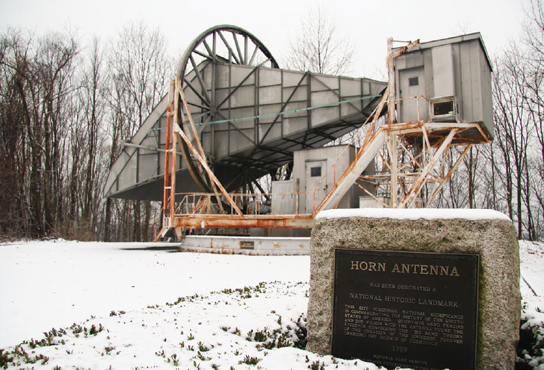1964
Cosmic Microwave Background
Arno Penzias (b. 1933), Robert Wilson (b. 1936)
Most cosmologists used Edwin Hubble’s 1929 discovery of the expansion of space as evidence that the universe was smaller in the past, and that if you could go far enough in the past (about 13.7 billion years ago, by the latest estimates), you would discover that the universe had sprung into being with a Big Bang from an extremely hot, dense, and small point.
Not all astronomers, however, initially embraced the big bang theory. For example, an alternate model was proposed in 1948 that hypothesized that even though space was expanding, new matter (mostly hydrogen) was constantly being created to keep the density (amount of matter per unit of volume) constant over time. Called the steady state theory, this model described a universe with no beginning and no end, and, as strange as it seemed, it was consistent with the available astronomical data of the time.
Cosmologists came up with ways to test between the Big Bang and steady state models of the universe. For example, in the big bang model, the universe today should still exhibit a faint residual glow, with a characteristic pattern from the early Recombination Era, when electrons were deionized and space became transparent to photons. Predictions were that the temperature of that glow would be around 3–5 kelvins, just above absolute zero. The steady state model was not consistent with background radiation of this predicted amount or pattern.
Radio astronomers knew that the radiation signal should be most detectable in the microwave part of the spectrum (around wavelengths of 1–2 millimeters), and the race was on to detect it. The race was won in 1964, when the astronomers Arno Penzias and Robert Wilson detected unexplained and near-uniform background radiation corresponding to a temperature near 3.5 kelvins. The discovery—made at Bell Labs, where radio astronomy had been invented in 1931 by Karl Jansky—earned them the 1978 Nobel Prize in Physics.
Subsequent space satellite measurements have revealed the cosmic microwave background to have a temperature of 2.725 kelvins, with very tiny fluctuations in matter and space that appear to be the “seeds” that eventually grew into stars and galaxies.
SEE ALSO Big Bang (c. 13.7 Billion BCE), Recombination Era (c. 13.7 Billion BCE), First Stars (c. 13.5 Billion BCE), Radio Astronomy (1931).
A photo of the historic horn-shaped radio antenna at Bell Labs in Holmdel, New Jersey, that was used by Arno Penzias and Robert Wilson to discover the faint glow of the cosmic microwave background emission that had been predicted by the big bang model for the origin of the universe.
